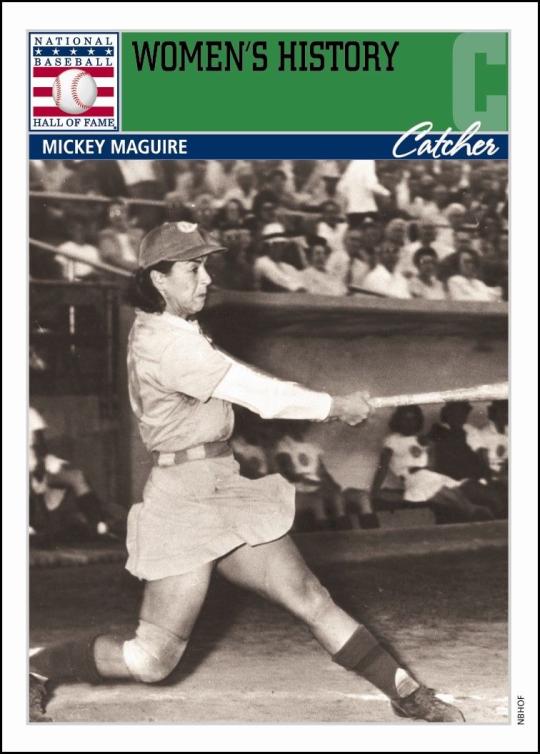Post-Visit: Women's History (Advanced)
Lesson
1. Begin this lesson by telling students that on June 23, 1972, President Richard Nixon signed the following into law:
"No person in the United States shall, on the basis of sex, be excluded from participation in, be denied the benefits of, or be subject to discrimination under any educational program or activity receiving federal financial assistance. . .” –Title IX of the Educational Amendments of 1972
2. Explain that schools receiving federal funding cannot discriminate against girls and women in educational programs including sports. The majority of schools in the United States, including elementary schools, high schools, and colleges, receive some federal funding. Not only do schools provide money to pay for competitive sport programs for girls and women, Title IX also requires schools to provide equal scholarships, sporting equipment, and coaching for girls' sports.
3. Ask students to share their thoughts on Title IX. How did women's opportunities for sport participation differ from men's opportunities for sport participation before Title IX was passed?
4. Have students consider some of the female baseball players and all-women's baseball teams they discussed during their learning experience with the Baseball Hall of Fame. How have opportunities for women in baseball changed since Title IX was passed?
5. Discuss that advocates of Title IX have claimed that it has opened the door for women in sports, while opponents believe that these improvements for women have come at the expense of men with the elimination of many of their programs and teams just to comply with the law.
Activity
Day 1
1. Divide students into four groups. Explain that two groups will research and develop arguments in favor of Title IX, and the other two groups will research and develop arguments against Title IX.
2. Go to the school library during your scheduled time slot. During this visit, each group should do research on Title IX using both primary and secondary sources. Each group should take notes that will help them develop their arguments for the debate. If students require more time, they may continue research outside of class.
3. Students should create a bibliography properly citing each of the sources they consulted for this project.
Day 2
4. On this day, have groups work together to review their notes and identify, at minimum, four quality arguments that support their position.
5. Groups should prepare to communicate their arguments in a three-minute presentation. Students are encouraged to use visual aids to support their presentations.
Day 3
6. Prepare your classroom for a debate. The classroom should be configured to allow enough space for students in each group to stand and present their arguments.
7. When it is time to debate, each group should give a three-minute presentation that presents the group's viewpoint, clearly identifies and describes its principal argument, and provides examples that support the argument.
8. Once the debate is complete, students may abandon their assigned positions and discuss the issue of Title IX.
Conclusion:
To conclude this lesson and check for understanding, ask students to write a journal response explaining Title IX in their own words, and stating their personal position on the law.
Common Core Standards
W.9-10.1., W.11-12.1. Write arguments to support claims in an analysis of substantive topics or texts, using valid reasoning and relevant and sufficient evidence.
W.9-10.7., W.11-12.7. Conduct short as well as more sustained research projects to answer a question (including a self-generated question) or solve a problem; narrow or broaden the inquiry when appropriate; synthesize multiple sources on the subject, demonstrating understanding of the subject under investigation.
W.9-10.8., W.11-12.8. Gather relevant information from multiple authoritative print and digital sources, using advanced searches effectively; assess the usefulness of each source in answering the research question; integrate information into the text selectively to maintain the flow of ideas, avoiding plagiarism and following a standard format for citation.
SL.9-10.1., SL.11-12.1. Initiate and participate effectively in a range of collaborative discussions (one-on-one, in groups, and teacher-led) with diverse partners on grade-appropriate topics, texts, and issues, building on others’ ideas and expressing their own clearly and persuasively.
SL.9-10.2., SL.11-12.2. Integrate multiple sources of information presented in diverse media or formats (e.g., visually, quantitatively, orally) evaluating the credibility and accuracy of each source.
SL.9-10.4., SL.11-12.4. Present information, findings, and supporting evidence clearly, concisely, and logically such that listeners can follow the line of reasoning and the organization, development, substance, and style are appropriate to purpose, audience, and task.
SL.9-10.5., SL.11-12.5. Make strategic use of digital media (e.g., textual, graphical, audio, visual, and interactive elements) in presentations to enhance understanding of findings, reasoning, and evidence and to add interest.
SL.9-10.6., SL.11-12.6. Adapt speech to a variety of contexts and tasks, demonstrating command of formal English when indicated or appropriate.

